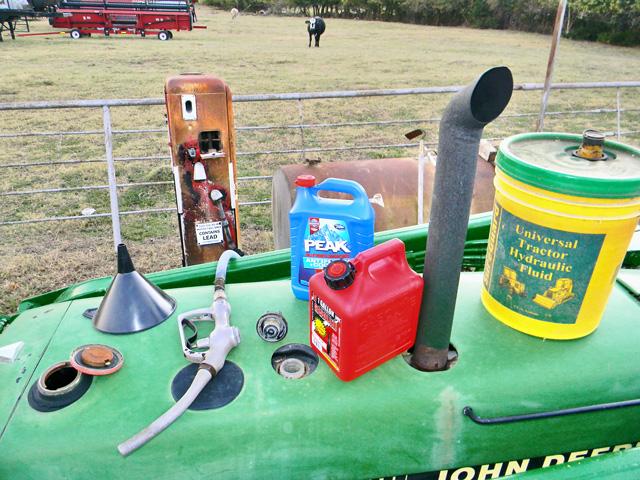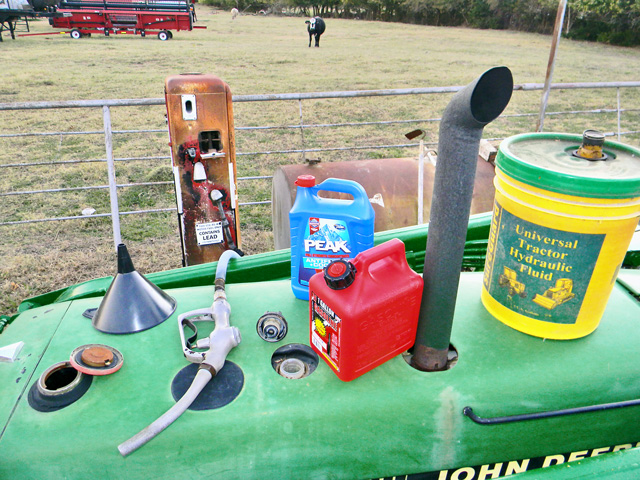MachineryLink
Ask the Mechanic: Easy Fixes to Fluid Mix-Ups
DTN/The Progressive Farmer's Ask The Mechanic Columnist Steve Thompson answers readers' mechanical questions. You can read Steve's columns every month in The Progressive Farmer's digital edition (click on the "Resources" tab to find the magazine and inside, Steve's Ask The Mechanic columns).
If you have any questions for him, you can contact Steve at: Steve Thompson at Ask The Mechanic, 2204 Lakeshore Dr., Suite 415, Birmingham, AL 35209, or email: mechanic@progressivefarmer.com.
Here are Steve's answers to three questions recently submitted by readers:
READER QUESTION:
My father has farmed with John Deere tractors since his father traded in a good set of mules at the John Deere dealer for a 1936 John Deere unstyled Model B, which we have restored. He got a little careless last week and topped off the cooling system with diesel on his 4440. Now, we have diesel in the cooling system. How do you recommend I deal with this problem?
STEVE'S ANSWER:
I have seen this before and almost have done it myself a time or two when in a hurry.
Your problem is not as harmful as filling the engine with hydraulic oil or, even worse, filling a diesel tractor with gasoline or antifreeze. The opportunities are endless. Since it is a good idea to drain and change the coolant every two years anyway, a coolant change won't be out of line this time. In order to clean the radiator, flush the radiator and cooling system with radiator flush a couple of times as recommended on the product. Then, refill with a 50-50 blend of coolant and distilled water. Or, available now is coolant that is already mixed. A 50-50 blend will keep an engine cooler than a straight fill of antifreeze.
P[L1] D[0x0] M[300x250] OOP[F] ADUNIT[] T[]
**
READER QUESTION:
I don't understand why an engine needs a timing advance. I have a 3010 John Deere diesel and a 3020 John Deere diesel. The 3010 has no timing advance in the injector pump, but the 3020 does. When I had the 3010 injector pump rebuilt, the rebuilder asked me if I wanted to add a timing advance in the 3010 pump. Why do I need it?
STEVE'S ANSWER:
I get the question about timing across my desk several times a year. The timing advance in an engine can be set up in several ways, but it's a way of making an engine more responsive, fuel efficient and powerful throughout its speed. It takes about 0.002 of a second for the explosion that begins the power stroke to reach its maximum force, and at that time, the piston needs to be about 12 degrees after it has begun its downward power stroke. At 1,000 rpms, the piston travels 16 degrees in 0.002 of a second. As the engine speed increases, the piston moves more degrees during this 0.002 explosion time, which is constant. So, if the engine is running at 1,000 rpms, the injection on a diesel (or spark on a gas engine) must occur at 4 degrees before the piston reaches top dead center for the maximum explosion to occur at 12 degrees past top dead center.
If the engine speed is increased to 2,000 rpms, the piston now travels 32 degrees during the 0.002 that's required for the explosion to reach its maximum power, so the injection or spark must occur at 20 degrees before top dead center for the maximum force to occur at 12 degrees after top dead center. Now you know why your 3010 has such a deep sound at idle. Without a timing advance in the pump, the timing is really off at idle speed, but it has to be for the engine to be in time at working speed. With the timing advance installed in your 3010, the engine will sound more like the 3020.
**
READER QUESTION:
When changing the engine oil in a truck or tractor, when do you think is the best time to drain the oil, when the engine is cold, or when the engine is hot?
STEVE'S ANSWER:
I like to let the engine warm to operating temperature, shut it down, wait a minute or so, and then drain the oil. This sequence allows the oil to circulate throughout the engine in a warm state and pick up as many contaminants as possible that are suspended in the warm liquid.
Waiting a minute or so before draining allows the warm oil throughout the engine to drain down, picking up more contaminants before it reaches the oil pan before draining. If possible, fill the new oil filter with oil before installing on the engine. This allows the oil pump to pressurize the system faster because it doesn't have to fill the oil filter before full oil pressure throughout the engine is reached.
**
Steve's "Back in the Day" New Year's Resolutions
1. I will train my dog so he doesn't dirty my truck windows with his nose.
2. I will fix the gate going into the pasture so that it will not drag.
3. I will not let the seed left in my grain drill get wet and sprout.
4. I will not put black tape over any unwanted warning lights on the tractor's dash.
5. I will not let my neighbor borrow my hay baler or chain saw.
(c) Copyright 2020 DTN, LLC. All rights reserved.





Comments
To comment, please Log In or Join our Community .